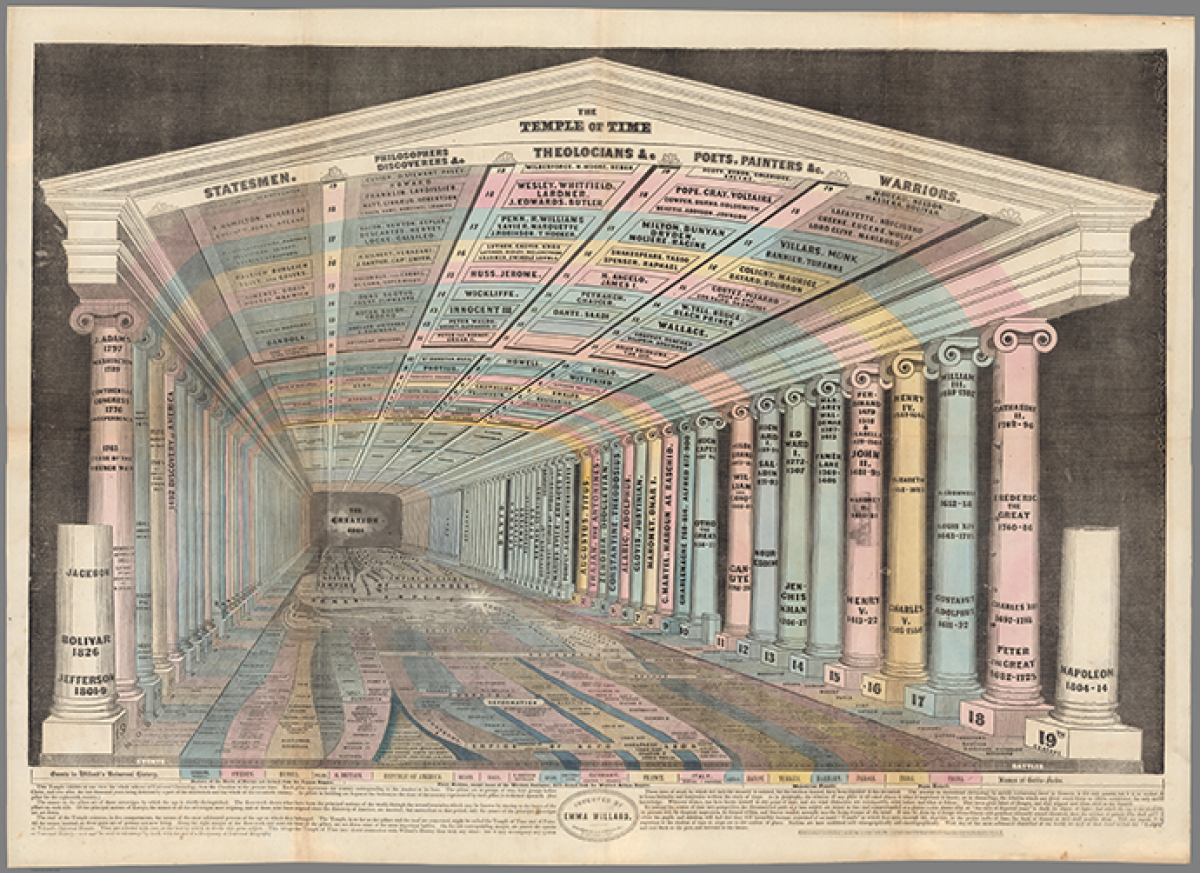DU Historian Explores the Achievements of an American Innovator

Emma Willard's "Temple of Time"
University of Denver history professor Susan Schulten is an expert on the life and works of one of the 19th century’s most innovative educators, portrayed in the recently published “Emma Willard, Maps of History” (Visionary Press, 2022). In an email interview with University of Denver Magazine, Schulten discusses her new book and Willard’s contributions to American education.
Emma Willard may be a household name for historians, geographers and cartographers, but much of the general public probably has not heard of her. Can you provide a brief introduction? What made her work so innovative?
Emma Hart Willard was a pathbreaking educator in more than one way. She was born into a family of ardent patriots just after the Revolution, and that identity shaped her entire life. She was among the first generation of girls to be educated outside the home, and she quickly realized that women could learn far more than what was then offered. At the first opportunity to teach students of her own, she began to provide a kind of college education to older girls, long before the first women’s colleges even opened their doors in the United States.
Even more important is the reach she had through her publications. As one of the best-selling textbook authors of the 19th century, her historical atlases, textbooks and wall charts had a wide reach. She saw firsthand how the “common,” or public, schools were reaching a broader cross section of American youth in the 1840s and tailored her publications to fit this growing population of students. She believed wholeheartedly that people learn best through visual and graphic pictures of information, and this guided her emphasis that everything be illustrated in some form.
Willard is considered a pioneering influence in the movement to offer educational opportunities to girls and women. What was her biggest contribution to this endeavor?
Her greatest legacy in this regard is her school, which in its earliest iteration was run out of her home in Middlebury, Vermont. Every morning in the 1810s, she woke up to see the enormous opportunities afforded to young men at the newly opened Middlebury College. But no such education was available for the sisters of these men, and that left her bitterly determined to widen the curriculum for her own emerging “scholars.” After a few years trying to convince the residents of Vermont to support education for women, she left in frustration, moving to the more hospitable terrain of New York state. There she established the Troy Female Seminary in 1821, which later became the Emma Willard School and which remains an eminent school for girls to this day. Her most famous pupil was Elizabeth Cady Stanton, the ardent suffragist, with whom she—ironically—strongly disagreed about the appropriateness of voting rights for women.
This book is part of a series focusing on graphic visionaries. How did you come to be involved in this project?
In the midst of the pandemic—late in 2020—a colleague in San Francisco named R.J. Andrews contacted me about the possibility of writing a book about Willard. He himself is a data visualization creator, known for his creative arrangement of information. He believed the time was right for a trio of books on the 19th century innovators of data graphics, and Willard was one of them. R.J. contacted me as the person who has written more than anyone else about Willard’s work and contribution. She is an extraordinarily complicated figure in American history: She was, of course, a pathbreaking educator of women and a tremendously innovative teacher and author. And yet she was also very much a product of her time, someone who believed wholeheartedly in Manifest Destiny and American exceptionalism.
What would you like readers to take away from this collection of maps, charts and atlases? Of all her works, do you have a favorite?
Willard’s graphic output grew directly out of her classroom experience. She began with the simple step of having students draw maps of the past, and that shaped her conviction that when students draw, they remember. She rapidly scaled up her approach through published atlases, textbooks and other materials. Her first illustration of time pictured the history of the Roman Empire as a massive river system. Perhaps the most stunning and mind-bending of these images is the Temple of Time, designed in the 1840s to capture the totality of human history on a single page. Willard foregrounded visual techniques such as this to help a wider population of students learn in an era of accelerating information. Spread over 40 years, her prodigious output reveals a woman who was reckoning with the very meaning of time and space in an era of expansion, dislocation and war.
An article on Schulten's new book appears in the winter issue of the University of Denver Magazine. Visit the magazine website for bonus content and to read this and other articles in their original format.








